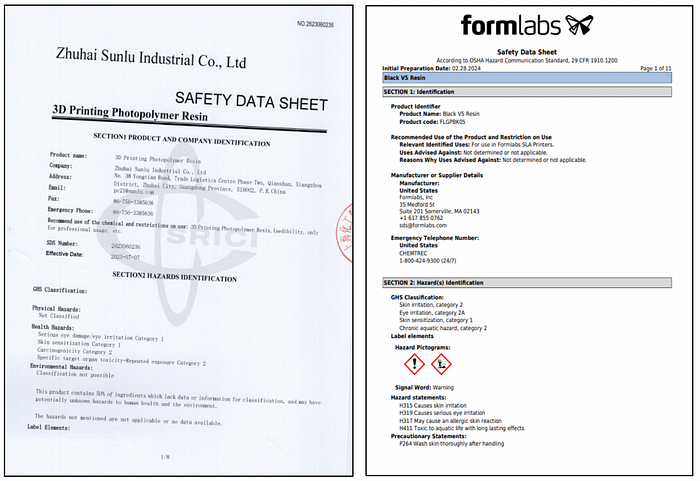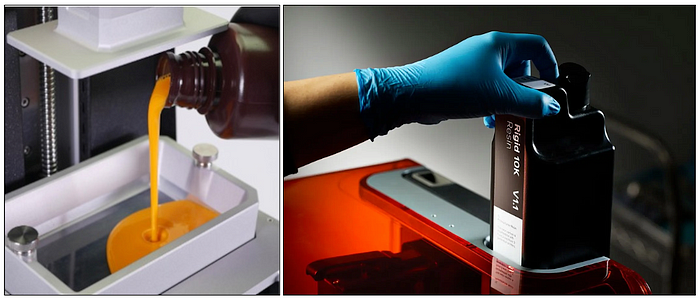
Safety Concerns with Low-Cost 3D Printing Resins
In recent years, the rise of low-cost (<$1,000) resin 3D printers has revolutionized the accessibility of 3D printing, allowing millions of individuals to begin printing from their homes. While the increased accessibility of 3D printing is undoubtedly a positive development, it has also brought about significant challenges.
A pervasive lack of safety information from many low-cost resin manufacturers has led to injuries, widespread misinformation and confusion within the community, resulting in users feeling uncertain and concerned about the necessary precautions to take when handling resin.
Two examples from Reddit: Reddit example 1, Reddit example 2
This article will:
-
Explain what ACMO (4-Acryloylmorpholine) is, one of the most common components of low-cost resins.
-
Discuss why Formlabs does not use it in our resins, and how we ensure a safer printing experience.
As a leader in the 3D printing industry, and as a company deeply committed to making resin 3D printing both accessible and safe, we believe it is our duty to address these issues head-on.
Known Issues with Low Cost Resins
The availability of low-cost 3D printing resins has surged, particularly on platforms like Amazon and Walmart. To cut costs and boost printing speeds, manufacturers often use cheap, highly reactive chemicals. While some of these components are safe and well understood, others can pose significant risks when exposed to skin and are harmful when inhaled.
One specific chemical that Formlabs has identified in a majority of low cost resins is called 4-Acryloylmorpholine or ACMO. ACMO is often included in 3D printing resins because it is inexpensive, which allows resin manufacturers to cut costs, and highly reactive, which speeds up print times.
However, the EPA has issued a SNUR, or a Significant New Use Regulation, for ACMO because of the dangerous effects of contacting skin and breathing in its vapors. If you’re active in the 3D printing community, you’ve likely seen countless users complaining of noxious fumes, along with headaches, and eye and throat irritation when near non-ventilated 3D printers, some of which may be traced back to the resin’s ACMO contents.

When ACMO is used as an ingredient in resin in the United States, the SNUR requires manufacturers to report its contents on the Safety Data Sheet (SDS) and to list the following human health hazard statements:
-
May cause damage to organs through prolonged or repeated exposure
-
Reproductive effects
When properly reported, which unfortunately it is often not, the SDS of a resin containing ACMO should look like this; compare that to the SDS from the Formlabs Creator Series:

Additionally, the EPA’s SNUR includes language about the regulations for releasing ACMO into waste water streams, stating that the limit is 100 ppb (parts per billion). To put this in perspective, the amount of water needed to dilute 1L of a resin formulation containing 50% ACMO is about 5 million liters of water, or roughly the size of two Olympic swimming pools.

This becomes especially important considering that many ACMO-containing resins are advertised as being “water washable” and marketed with images of parts being washed in household sinks, with the resulting water/resin mixture traveling directly into water streams.
While many users properly wash and dispose of their leftover water/resin mixtures, the misleading marketing can lead to improper disposal methods. This not only poses a risk to the environment but also to public health, as these chemicals can contaminate water supplies. The seemingly benign term “water washable” also may give users the false impression that these resins are safe to handle without gloves or other protective gear, further increasing the risk of skin irritation or more serious health issues. So-called “water-washable” resins that contain ACMOs are a public health and environmental disaster in the making.
How to Recognize if Your Resin Has ACMO In It
ACMO can also be recognized on Safety Data Sheets by its chemical number, or CAS Registry Number, of 5117–12–4. Always read the SDS to better understand the safety information and be aware of ACMO contents.
When printing with ACMO containing resins, use of a respirator and ventilation is highly recommended and legally required when operating in a professional setting. For example, at our facility in Somerville, Formlabs does not allow employees to print with ACMO containing resins unless printers are placed in an industrial grade fume hood and proper PPE (personal protective equipment) is used.
If you believe you have been negatively affected by a 3D printing resin containing ACMO, file a report with the US Consumer Product Safety Commission here.
Read an example of an incident report with an ACMO-containing resin.
Ask Your Vendor
Unfortunately, not all resins that contain ACMO adhere to the SNUR’s safety labeling requirement and as a result, users have been left in the dark on the potential health effects. Formlabs Materials Scientists have investigated over 70 of these resins from 17 different manufacturers. A large majority of General Purpose, High Speed, and ABS-Like Resins contain more than 30% ACMO in their formulations, with many containing up to 60%.
Below is a list of resin manufacturers identified that use ACMO in their resin formulations:
-
Elegoo
-
Anycubic
-
SUNLU
-
Phrozen
-
Siraya Tech
-
UNIZ
-
HeyGears
-
Creality
-
eSun
-
Ameralabs
Download a list of 3D printing resins that contain ACMO here.
What’s Different About Formlabs?
“We build the tools that make it possible for anyone to bring their ideas to life.”
Since our inception in 2011, Formlabs has centered itself on the mission of accessibility. We strive to engineer the most intuitive, easy to use, and affordable products that will allow our customers to solve real world problems. But accessibility isn’t just about designing a good UI and lowering prices — it’s also about intentionally creating an ecosystem that enables safe operation in a variety of environments with a large range of users.
Along the way we’ve made thousands of design decisions that all add up to the most well documented and safe to use resin printing ecosystem on the market. To list a few…
-
Resin Formulations: We’ve built a team of 30+ PhD Material Scientists who engineer all of our resins in-house. Across our 40+ unique resins offerings, none of them require the use of a fume hood or respirator. Our resins have been designed to be similar to or safer than other household chemicals or adhesives.
2. Resin Production Facility: Unlike most low cost resins, many of which are produced from a small number of chemical suppliers in China, Formlabs owns and operates our resin producing facility in Ohio. All employees are provided with the appropriate PPE and training to ensure that every batch of resin is produced to the highest standards of quality control, and that our employees are safe while doing so.
Read more about our certifications here.
3. Documentation and Compliance: Understanding the safety information associated with resin 3D printing is not always simple or easy to digest. The safety and associated post-processing information from low cost resin manufacturers is often hard and sometimes even impossible to find, and does not always list the necessary washing or curing parameters required to create safe-to-handle finished parts.
Formlabs is committed to publishing every Safety Data Sheet (SDS) and Technical Data Sheet (TDS) in an easy to find location and in every language we service, so that you always know what you’re getting.

Find all SDS and TDS information in the Formlabs Materials Catalog.
4. A Printer Ecosystem Designed to Reduce Contact with Resin: Our printer ecosystem was meticulously designed to minimize user contact with resin and IPA through a series of thoughtful product design choices. From our auto-dispensing resin cartridges to our easy to store and handle resin tanks, every aspect of our system prioritizes safety and ease of use.

Conclusion
It’s becoming more and more evident that not all resins are created equal. At Formlabs, we are dedicated to maintaining and setting higher standards of safety and quality in the resin 3D printing industry. We prioritize providing comprehensive information, proper safety guidelines, and reliable documentation to ensure that our users can print with confidence and peace of mind.
Recognizing the safety concerns that come with resin printing, the Creator Resins were developed with a focus on reducing potential risks while keeping them affordable. These resins are formulated to be safer for hobbyists and consumers, with ingredients that lower the likelihood of serious skin irritation, though gloves are still recommended. By balancing safety with cost-effectiveness, we’re enabling more people to enjoy the benefits of resin printing without compromising on their well-being.
Additionally, in an effort to allow anyone to produce reliable and robust 3D printed parts safely, we are now releasing print settings for our General Purpose V5 and Tough 2000 V1.1 resins to be used in a variety of low-cost resin 3D printers. Access the settings here, or directly through Chitubox and Lychee Slicers.
As the popularity of resin 3D printing continues to grow, it is crucial for users to be discerning about the products they bring into their homes. By being informed and cautious, you can enjoy the benefits of resin 3D printing while safeguarding your health and the environment. Investing in high-quality resins and equipment is not just about achieving better prints — it’s about ensuring a safer and more sustainable future for the entire 3D printing community.
